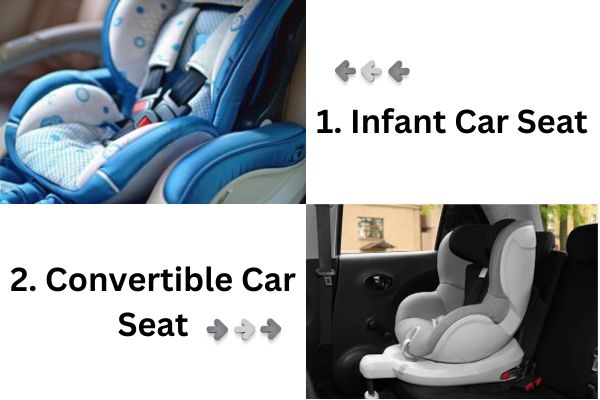Making sure your child is safe in the car is your first priority as a parent. Because every state has separate regulations for newborns, toddlers, and older children, navigating the car seat laws by state can be somewhat difficult. We’ll streamline the procedure in this tutorial by going over each kind of seat and breaking down the regulations by state. We’ll also address frequently asked questions, such as how old to sit in front seat?, when can a kid sit in the front seat and how long are infant car seats good for.
- Why Car Seat Laws Are Important
- Types of Car Seats and Stages
- State-by-State Breakdown of Car Seat Laws
- When Can a Kid Sit in the Front Seat?
- A Step-by-Step Guide to Choosing the Right Car Seat
- Important Safety Tips for Parents
- Final Thoughts: Buy with Confidence
- Commonly Asked Questions About Car Seat Laws
Why Car Seat Laws Are Important
Car seats are necessary for keeping kids safe when traveling by car. According to studies, using car seats correctly can minimize the chance of getting hurt in an accident by up to 71%. To guarantee that children are securely confined according to their age, weight, and height, each state has its own set of regulations. To keep your child safe while driving, you must abide by these laws.
Types of Car Seats and Stages

Understanding the different types of car seats is the first step to following the laws accurately:
1. Infant Car Seat:
Made exclusively for babies, this seat faces rearward. Children up to 32 inches or 35 pounds can usually fit in this seat.
2. Convertible Car Seat:
When the child becomes older, the seat can be turned from rear-facing to forward-facing. Depending on the model, it can fit kids as young as infancy up to 65 pounds.
3. Booster Seat:

Made for older kids who weigh between forty and one hundred pounds. Booster seats assist in properly positioning the seatbelt across a child’s lap and chest.
4. Seatbelt Only:
A youngster may only need a seatbelt to be securely restrained after they reach a specific height and weight.
State-by-State Breakdown of Car Seat Laws

Each state has specific car seat regulations, and it’s essential to know your state’s guidelines.
1. California
- Infant Car Seat: Rear-facing until age 2 or until they reach the maximum height and weight limit of the seat.
- Convertible Car Seat: Forward-facing from age 2 up to 65 pounds.
- Booster Seat: Required until age 8 or until the child reaches 4’9″ in height.
- Front Seat Minimum Age: 8 years old.
2. Texas
- Infant Car Seat: Rear-facing until age 2.
- Convertible Car Seat: Forward-facing up to 65 pounds.
- Booster Seat: Required until age 8 or until the child reaches 4’9″ in height.
- Front Seat Minimum Age: 13 years old.
3. Florida
- Infant Car Seat: Rear-facing until age 1 or until they reach 20 pounds.
- Convertible Car Seat: Forward-facing up to 65 pounds.
- Booster Seat: Required until age 5.
- Front Seat Minimum Age: 12 years old.
4. New York
- Infant Car Seat: Rear-facing until age 2.
- Convertible Car Seat: Forward-facing up to 65 pounds.
- Booster Seat: Required until age 8 or until the child reaches 4’9″.
- Front Seat Minimum Age: 12 years old.
5. Illinois
- Infant Car Seat: Rear-facing until age 2 or until they exceed the height and weight limits.
- Convertible Car Seat: Forward-facing up to 40 pounds.
- Booster Seat: Required until age 8 or until the child reaches 4’9″.
- Front Seat Minimum Age: 13 years old.
6. Ohio
- Infant Car Seat: Rear-facing until age 1 and at least 20 pounds.
- Convertible Car Seat: Forward-facing up to 65 pounds.
- Booster Seat: Required until age 8 or until the child reaches 4’9″.
- Front Seat Minimum Age: 13 years old.
7. Pennsylvania
- Infant Car Seat: Rear-facing until age 2 or until the maximum weight limit is reached.
- Convertible Car Seat: Forward-facing up to 65 pounds.
- Booster Seat: Required until age 8 or until the child reaches 4’9″.
- Front Seat Minimum Age: 8 years old.
8. Georgia
- Infant Car Seat: Rear-facing until age 1 and at least 20 pounds.
- Convertible Car Seat: Forward-facing up to 40 pounds.
- Booster Seat: Required until age 8 or until the child reaches 4’9″.
- Front Seat Minimum Age: 8 years old.
9. Virginia
- Infant Car Seat: Rear-facing until age 2 or until they exceed the height and weight limits.
- Convertible Car Seat: Forward-facing up to 55 pounds.
- Booster Seat: Required until age 8 or until the child reaches 4’9″.
- Front Seat Minimum Age: 8 years old.
10. Washington
- Infant Car Seat: Rear-facing until age 2.
- Convertible Car Seat: Forward-facing up to 65 pounds.
- Booster Seat: Required until age 8 or until the child reaches 4’9″.
- Front Seat Minimum Age: 13 years old.
When Can a Kid Sit in the Front Seat?
Since the rear seat is the safest for kids, it is generally advised that they sit there until they are at least 13 years old. However, if a child reaches a specific age or weight, several states let them to sit in the front seat. Below is a summary of typical age requirements:
• Ages 8 to 12: Children must stay in the back seat until they are at least eight years old in the majority of states.
• 13 years of age and up: In many areas, children must be at least 13 years old to securely sit in the front seat.
These age restrictions are justified by the child’s bone development and the location of airbags, which can seriously endanger smaller, younger youngsters.
A Step-by-Step Guide to Choosing the Right Car Seat

1. Determine the Age, Weight, and Height of Your Child: This is the first step in choosing an appropriate car seat.
2. Select the Correct Type of Car Seat: based on the stages we discussed (infant, convertible, booster).
3. Verify State-Specific Regulations: Pay attention to any modifications as every state has its own set of car seat laws.
4.Installing a car seat correctly requires adhering to the manufacturer’s instructions. If in doubt, a lot of hospitals and fire stations do car seat installation tests.
5. Keep an eye on the transition time: Assess your child’s car seat fit on a regular basis to decide when it’s time to advance to the next level.
Important Safety Tips for Parents

Following car seat laws is just one part of keeping your child safe. Here are some additional safety tips:
When at all possible, choose the back seat; for kids under 13, this is the safest option.
• Never Use a Damaged Car Seat: Even if your car seat seems to be in fine shape, it is preferable to replace it if it has been in an accident.
• Verify Expiration Dates: Automobile seats are marked with an expiration date, usually six to ten years from the date of manufacturing.
• Verify the Seatbelt Fit: In a booster seat, make sure the belt properly crosses your child’s lap and chest.
Final Thoughts: Buy with Confidence
Following these recommendations and being aware of state-specific car seat legislation will help keep your child safe when traveling. Prioritize comfort and safety when selecting a car seat, and don’t be afraid to spend more on high-quality models. A well-chosen car seat provides safety and peace of mind, allowing you to drive with assurance that your child is safe.
You’re already taking preventative measures to keep your child safe on every ride by doing these things and researching the regulations in your state.
Commonly Asked Questions About Car Seat Laws
1. What is the legal age for a child to sit in the front seat?
The legal age varies by state, but most recommend that children remain in the back seat until at least 13 years old for safety reasons.
2: What are the Infant Car Seat Laws?
Infant car seat laws mandate that infants be placed in rear-facing seats from birth. Although it is safer to keep newborns in rear-facing car seats until they outgrow the height and weight restrictions of the seat, many states require them to do so until they are at least one or two years old.
3: Which is the Standard Color for Car Seats Worldwide?
When searching for a car seat, many parents are interested in the typical hue found worldwide. Car seats come in a wide range of colors and designs, and there is no universally accepted color. However, dark colors like gray and black are most commonly utilized since they help to minimize visible stains and wear.
4. When can I transition my child from a car seat to a booster seat?
Children typically transition to a booster seat when they outgrow their convertible car seat, usually around 40 pounds or when they reach the height limit of the car seat.
5. How long should my child stay in a rear-facing car seat?
Most states recommend keeping your child in a rear-facing car seat until they are at least 1 or 2 years old, but it’s safer to remain rear-facing until they outgrow the seat’s weight and height limits.





